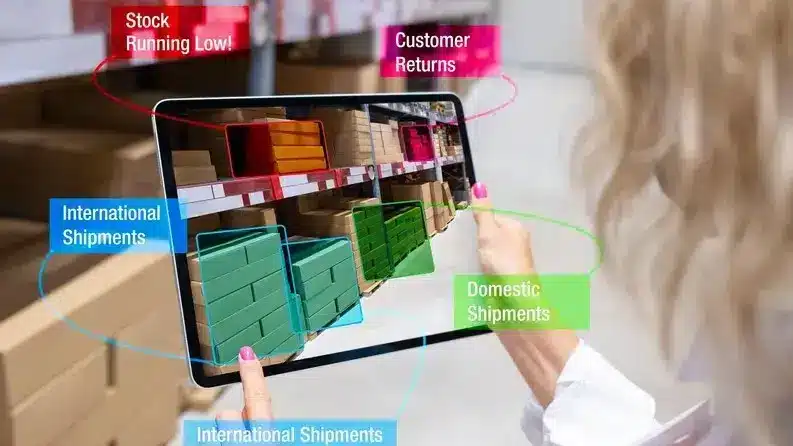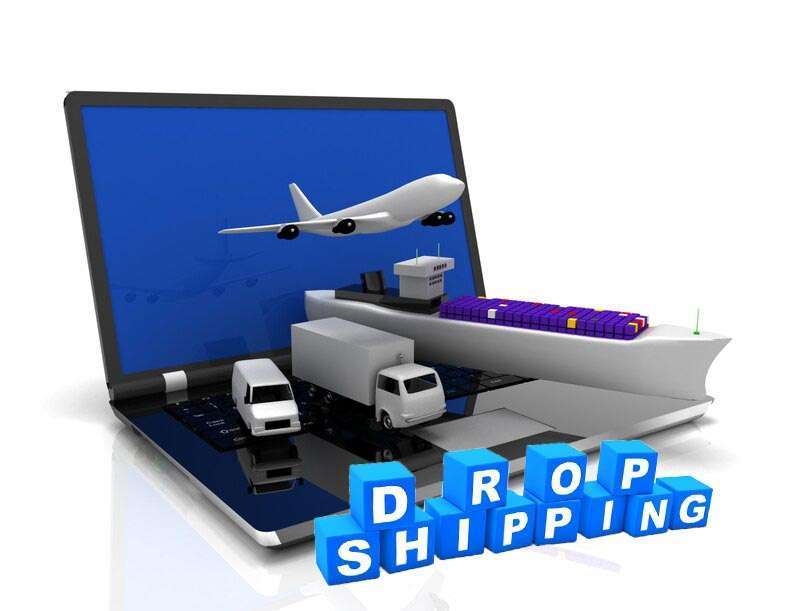Introduction
Get ready to dive headfirst into the exhilarating world of dropshipping – a thrilling venture that holds the promise of financial freedom and extraordinary business triumphs! This empowering guide is your passport to not just launching but conquering your very own dropshipping empire.
We’re arming you with a treasure trove of knowledge and an arsenal of tools meticulously curated to ensure your resounding success in this dynamic industry. Whether you’re just starting out or aiming to ascend to new heights, this article is your trusted companion.
It’s your compass through the fundamentals and your beacon to mastering the most advanced strategies. Every step of this journey is an opportunity for greatness. Are you ready to seize it? The path to prosperity is paved with possibilities, and dropshipping is your chariot to ride into a future of boundless achievement!
Also read: Affiliate Marketing: The Fundamentals You Need to Succeed(Moumentec)
1. Understanding Dropshipping: A Comprehensive Guide
1.1. What is Dropshipping?
Embark on an exhilarating entrepreneurial journey with the dynamic and liberating world of dropshipping! Picture this: you have the power to offer an array of captivating products to your eager customers, all without the burden of managing inventory.
When a customer makes a choice, the magic happens – the product is swiftly dispatched straight from the supplier to their doorstep, bypassing the need for a traditional storefront or a space-consuming warehouse.
It’s a game-changer, an opportunity that beckons aspiring online trailblazers with its sheer potential and promise. Are you ready to step into this realm of boundless possibilities and shape your own destiny? The path to success awaits, and dropshipping is your key to unlocking it!

1.2. How Does Dropshipping Work?
The dropshipping process involves several key steps:
- Customer Places an Order: A customer places an order on your online store at the retail price.
- Order is Forwarded to the Supplier: The order details are then forwarded to the supplier, along with the wholesale price of the product.
- Supplier Ships the Product: The supplier ships the product directly to the customer, without any branding or mention of your business.
- You Keep the Profit: The difference between the retail price and the wholesale price is your profit.
1.3. Advantages of Dropshipping
- Low Startup Costs: Dropshipping eliminates the need for significant upfront investments in inventory, allowing you to start your business with minimal capital.
- Low Overhead Costs: Since you don’t have to manage a warehouse or inventory, your operational costs are significantly reduced.
- Wide Product Selection: With dropshipping, you can offer a vast range of products without the constraints of physical storage space.
- Flexibility and Mobility: As a dropshipper, you can run your business from anywhere with an internet connection, providing you with unparalleled flexibility.
1.4. Challenges of Dropshipping
- Reliance on Suppliers: Your business is dependent on the reliability and efficiency of your suppliers. Choosing the right ones is crucial.
- Thinner Profit Margins: While startup costs are low, profit margins in dropshipping tend to be lower compared to businesses that hold inventory.
- Customer Service and Returns: Since you don’t handle the products directly, resolving customer issues and returns can be more challenging.
2. Setting Up Your Dropshipping Business
2.1. Niche Selection: Finding Your Profitable Corner
Choosing the perfect niche is nothing short of being the architect of your triumphant dropshipping journey. It’s a pivotal moment, a defining choice that can propel you toward building a thriving, prosperous business that fulfills your wildest dreams.
This is your opportunity to sculpt your own path to success! Dive headfirst into this incredible realm where every niche is a world of possibilities waiting to be conquered. It’s your chance to set the stage for your spectacular ascent in the world of dropshipping.
The niche you choose is not just a decision; it’s a declaration of your unwavering commitment to success. So, are you ready to embark on this electrifying quest for your niche, where every step you take brings you closer to your entrepreneurial dreams? The right niche is your key to unlocking a world of achievement!
2.2. Selecting the Right Suppliers
Selecting reliable and reputable suppliers is indeed a critical aspect of running a successful dropshipping business. Here are some factors to consider, red flags to watch out for, and tips for building strong supplier relationships:
Factors to Consider When Selecting Suppliers:
- Product Quality and Reliability:
- Ensure the supplier offers high-quality products that meet or exceed your customers’ expectations.
- Look for suppliers with a proven track record of reliable and consistent product delivery.
- Pricing and Profit Margins: Compare the prices offered by different suppliers to ensure they align with your pricing strategy and allow for a reasonable profit margin.
- Shipping and Delivery Times: Check the shipping options available and the estimated delivery times to ensure they meet your customers’ expectations. Slow shipping can lead to customer dissatisfaction.
- Inventory Levels: Ensure the supplier maintains adequate stock levels to prevent out-of-stock situations, which can lead to customer frustration.
- Communication and Responsiveness: A supplier who communicates clearly and promptly is essential for a smooth business operation. They should be responsive to your inquiries and provide updates on orders.
- Return and Refund Policies: Understand the supplier’s policies regarding returns, exchanges, and refunds. This information is crucial for handling customer service issues.
- Customer Reviews and Ratings: Look for feedback from other businesses or customers who have worked with the supplier. This can give you insights into their reputation and reliability.
- Location and Shipping Costs: Consider where the supplier is located, as this can affect shipping costs and times. A closer supplier may offer faster and cheaper shipping options.
- Payment Terms and Methods: Understand the payment terms and methods the supplier accepts. Ensure they are compatible with your business’s financial setup.
- Legal Compliance and Certifications: Confirm that the supplier complies with any necessary legal requirements and industry standards. This can include certifications for quality, safety, and ethical practices.
Red Flags to Watch Out For:
- Inconsistent Communication: If a supplier is slow to respond or provides vague information, it could be a sign of unreliable service.
- Lack of Transparency: Suppliers should be open about their products, pricing, and policies. If they are evasive or unwilling to share information, it’s a cause for concern.
- Unrealistically Low Prices: Be cautious of suppliers offering significantly lower prices than the market average. This may indicate low-quality products or unreliable service.
- Negative Reviews and Ratings: Pay attention to negative feedback or low ratings from other businesses or customers. This could indicate a history of issues with the supplier.
- Frequent Stockouts: If a supplier consistently runs out of stock, it can lead to disruptions in your business operations.
- Unsatisfactory Return Policies: Beware of suppliers with strict or unreasonable return policies. This can complicate customer service and lead to dissatisfaction.
Tips for Building Strong Supplier Relationships:
- Open and Transparent Communication: Establish clear lines of communication and maintain open dialogues with your suppliers. This helps in addressing issues promptly and building trust.
- Negotiate Favorable Terms: Work with your suppliers to negotiate terms that benefit both parties, such as pricing, payment terms, and minimum order quantities.
- Provide Feedback: Regularly share feedback with your suppliers, both positive and constructive. This helps improve the quality of their products and services.
- Be Reliable and Professional: Consistently meet your commitments, such as placing orders on time and paying invoices promptly. This builds a reputation for reliability.
- Build a Long-Term Partnership: Consider your suppliers as long-term partners in your business. This perspective encourages mutual trust and a commitment to each other’s success.
- Stay Informed About Industry Trends: Keep your suppliers informed about any changes or trends in your industry that may affect your product offerings. This collaborative approach can lead to better outcomes.
Remember, selecting and maintaining strong relationships with reliable suppliers is an ongoing process. Regularly evaluating their performance and being open to exploring new options can help ensure the success of your dropshipping business in the long run.
2.3. Building Your E-commerce Platform
Building a successful dropshipping business requires careful consideration when selecting and customizing your e-commerce platform. Here’s a step-by-step guide to help you choose the right platform, customize it to fit your brand, and optimize it for user experience and conversions:
Step 1: Choosing the Right E-commerce Platform
Consider Your Needs:
- Ease of Use: Look for platforms that are user-friendly and easy to navigate. This will make it simpler to manage your store and add products.
- Features: Ensure the platform provides essential features like product management, order processing, payment integration, and inventory tracking.
- Scalability: Choose a platform that can grow with your business. You don’t want to outgrow your platform as your business expands.
Popular E-commerce Platforms:
- Shopify: Known for its user-friendliness and a wide range of customizable templates and apps.
- WooCommerce (for WordPress): Highly customizable, especially if you’re familiar with WordPress.
- Big Cartel: Ideal for smaller businesses with a focus on simplicity and unique, handmade products.
- Magento: Offers advanced features and is suitable for larger enterprises.
Step 2: Customizing Your E-commerce Platform
Choose a Suitable Theme: Select a theme that aligns with your brand’s aesthetics and values. Many platforms offer a variety of free and paid themes.
Branding Elements:
- Logo: Upload a high-quality logo that represents your brand.
- Color Scheme: Use colors that reflect your brand’s identity. Consistency is key.
Customizing Product Listings:
- High-Quality Images: Use clear, high-resolution images that showcase your products effectively.
- Compelling Product Descriptions: Write detailed, accurate, and persuasive descriptions that highlight the benefits of each product.
- Pricing Strategy: Set competitive prices that also allow for a reasonable profit margin.
Add Trust-Building Elements:
- Customer Reviews and Testimonials: Encourage and showcase positive feedback from previous customers.
- Security Badges: Display secure payment icons and SSL certificates to build trust.
Step 3: Optimizing for User Experience and Conversions
Mobile Optimization: Ensure your website is mobile-friendly. Many users shop on their smartphones, so a responsive design is crucial.
Site Speed: Optimize images, minimize unnecessary scripts, and use caching to improve loading times. Slow websites lead to higher bounce rates.
User-Friendly Navigation: Make sure visitors can easily find what they’re looking for. Use clear categories, filters, and a search function.
Clear Call-to-Actions (CTAs): Use persuasive language and visually appealing buttons to guide users toward making a purchase.
Streamline Checkout Process: Keep the checkout process as simple and straightforward as possible. Reduce the number of steps and require only essential information.
A/B Testing: Experiment with different layouts, CTAs, and product placements to see what works best for your audience.
Analytics and Monitoring: Use tools like Google Analytics to track user behavior, traffic sources, and conversion rates. This data will help you make informed decisions for optimization.
Ongoing Maintenance and Updates: Regularly update your products, content, and promotions to keep your site fresh and engaging.
By following these steps, you can create a solid foundation for your dropshipping business. Remember to continuously monitor and adapt your strategy based on customer feedback and performance metrics to ensure long-term success.
2.4. Optimizing Your Website for Conversions
A well-optimized website is crucial for converting visitors into paying customers. Here are strategies to improve website speed, navigation, product listings, and checkout process to maximize conversions:
Optimize Website Speed:
- Compress Images: Use tools or plugins to compress images without compromising quality. This reduces page load times.
- Minimize HTTP Requests: Reduce the number of elements (images, scripts, stylesheets) on a page to minimize HTTP requests.
- Utilize Browser Caching: Set up caching to store frequently accessed resources in a visitor’s browser, reducing load times for returning users.
- Use Content Delivery Network (CDN): A CDN distributes your website’s content across servers worldwide, reducing server load and improving load times for users across different locations.
Enhance Navigation:
- Intuitive Menu Structure: Ensure that your menu is well-organized and easy to navigate. Use clear labels and logical categories.
- Search Functionality: Implement a robust search feature with filters and suggestions to help users find products quickly.
- Breadcrumb Navigation: This helps users understand their location on the website and easily navigate back to previous pages.
Optimize Product Listings:
- High-Quality Product Images and Descriptions: Provide clear, high-resolution images and detailed descriptions to give users a comprehensive view of the product.
- User Reviews and Ratings: Displaying reviews and ratings can build trust and provide valuable insights for potential buyers.
- Filtering and Sorting Options: Allow users to filter and sort products based on relevant criteria like price, size, color, etc.
Streamline Checkout Process:
- Guest Checkout Option: Allow users to check out without creating an account. This reduces friction for first-time buyers.
- Clear Call-to-Actions (CTAs): Use prominent and clear buttons to guide users through the checkout process.
- Progress Indicators: Show users where they are in the checkout process to provide a sense of progress and reduce abandonment.
- Multiple Payment Options: Provide various payment methods to accommodate different customer preferences.
Implement Mobile Optimization:
- Responsive Design: Ensure your website is mobile-friendly to cater to users on different devices. Google prioritizes mobile-friendly sites in search results.
- Accelerated Mobile Pages (AMP): Use AMP to create fast-loading, mobile-specific versions of your pages for an even better user experience.
Reduce Distractions and Clutter:
- Clear Calls to Action (CTAs): Avoid overwhelming users with too many options. Direct their attention to the most important actions you want them to take.
- Remove Unnecessary Elements: Minimize distractions by removing unnecessary pop-ups, banners, or excessive advertisements.
Regularly Test and Monitor:
- A/B Testing: Experiment with different elements on your website (e.g., button colors, CTA text) to see what resonates best with your audience.
- Monitor Analytics: Use tools like Google Analytics to track user behavior and identify areas for improvement.
Optimize for SEO:
- Fast Loading Speed: Page speed is a ranking factor for search engines, so a fast-loading website can improve your SEO.
- Mobile Optimization: Mobile-friendliness is important for both user experience and SEO rankings.
By implementing these strategies, you can create a well-optimized website that provides a seamless experience for visitors, ultimately increasing the likelihood of converting them into paying customers. Keep in mind that continuous monitoring and testing are essential to refine and improve the conversion rate over time.
2.5. Implementing Effective Marketing Strategies
To attract and retain customers, it’s crucial to have a comprehensive marketing plan in place that utilizes various channels and strategies. Here is an in-depth overview of some key marketing channels and strategies:
Social Media Marketing:
- Overview: Social media marketing involves using platforms like Facebook, Instagram, Twitter, LinkedIn, and others to promote your products or services, engage with your audience, and build brand awareness.
- Strategies:
- Content Creation: Create engaging and relevant content (images, videos, posts) that resonate with your target audience.
- Audience Engagement: Respond promptly to comments, messages, and interactions to foster a sense of community.
- Paid Advertising: Utilize paid social media advertising to reach a broader audience and target specific demographics.
- Influencer Marketing: Partner with influencers who have a large and engaged following to promote your products/services.
- Analytics and Insights: Use data to track performance and adjust your strategy accordingly.
Content Marketing:
- Overview: Content marketing involves creating and distributing valuable, relevant content to attract and engage a target audience. This content can be in various forms such as blog posts, videos, infographics, podcasts, and more.
- Strategies:
- Keyword Research and SEO: Identify relevant keywords and optimize content for search engines to improve visibility.
- Quality and Consistency: Ensure content is high-quality, informative, and consistent in its delivery.
- Guest Posting and Partnerships: Collaborate with other websites or influencers to expand your reach.
- Email Newsletter: Use content to nurture leads and keep subscribers engaged through regular email updates.
Email Marketing:
- Overview: Email marketing involves sending targeted messages to a list of subscribers. It’s an effective way to nurture leads, promote products, and maintain customer engagement.
- Strategies:
- Segmentation: Divide your email list into smaller segments based on factors like behavior, preferences, or demographics to send more personalized messages.
- Automation: Set up automated email campaigns triggered by specific actions or events, such as abandoned cart reminders or welcome emails.
- A/B Testing: Experiment with different elements (subject lines, content, visuals) to optimize open and click-through rates.
- Analytics and Reporting: Monitor metrics like open rates, click rates, and conversion rates to assess the effectiveness of your campaigns.
Paid Advertising:
- Overview: Paid advertising involves paying to display your messages or content to a specific audience through channels like search engines (Google Ads), social media platforms (Facebook Ads), display networks, and more.
- Strategies:
- Targeting: Define your target audience based on demographics, interests, and behaviors to ensure your ads reach the right people.
- Budget Management: Allocate your advertising budget wisely and monitor performance to maximize ROI.
- Ad Copy and Creative: Craft compelling ad copy and visuals that resonate with your target audience and encourage action.
- Testing and Optimization: Continuously test different ad variations and strategies to refine your approach.
Remember, an effective marketing strategy often involves a combination of these channels to create a cohesive and multi-faceted approach. It’s also important to continuously monitor and adapt your strategies based on performance metrics and changes in your target audience’s behavior.
3. Managing Operations and Customer Service

3.1. Order Fulfillment and Inventory Management
Efficient order fulfillment and inventory management are crucial for a smooth operation in any business that deals with physical products. Here are some best practices for managing orders, tracking inventory levels, and ensuring timely delivery to customers:
Implement an Inventory Management System: Use specialized software or an integrated Enterprise Resource Planning (ERP) system to track and manage inventory levels. This system should provide real-time visibility into stock levels, order statuses, and reorder points.
Set Reorder Points and Safety Stock Levels: Determine the minimum quantity of each product you should have in stock to avoid stockouts. This is known as the reorder point. Additionally, maintain a safe stock level to account for unexpected spikes in demand.
Categorize and Organize Inventory: Group similar items together, use clear labeling and organize inventory in a logical manner. This makes it easier for employees to locate and pick items efficiently.
Regularly Conduct Physical Counts: Perform regular physical counts to compare with the records in your inventory management system. This helps identify discrepancies and prevent stockouts or overstocking.
Utilize FIFO or LIFO Methods: Implement First-In-First-Out (FIFO) or Last-In-First-Out (LIFO) methods to manage perishable or time-sensitive inventory. This ensures that older stock is used or sold first.
Supplier Relationship Management: Cultivate strong relationships with suppliers. Communicate clearly about lead times, order quantities, and any potential delays. This can help ensure a steady supply of products.
Automate Order Processing: Use automation tools to streamline order processing. This can include automatic order confirmation emails, invoice generation, and integration with shipping carriers.
Implement Just-in-Time (JIT) Inventory Management: JIT helps minimize excess inventory by ordering goods only when needed. This can reduce carrying costs and free up capital for other business needs.
Monitor Sales Trends and Seasonality: Analyze historical sales data to identify patterns and seasonality in customer demand. This can help in making more accurate forecasts and planning inventory levels accordingly.
Utilize Demand Forecasting: Use advanced analytics and forecasting tools to predict future demand trends. This can help in making informed decisions about stock levels and ordering quantities.
Quality Control and Inspection: Conduct regular quality checks to ensure that the products in stock meet your standards. This helps avoid issues with customer satisfaction and returns.
Optimize Packaging and Shipping Processes: Efficient packaging and shipping processes can lead to faster order processing and delivery times. Consider using standardized packaging to save time and reduce costs.
Implement a Returns and Exchanges Process: Have a clear and efficient process for handling returns and exchanges. This ensures that returned products are properly accounted for and can be restocked or disposed of as necessary.
Monitor Key Performance Indicators (KPIs): Track relevant metrics like order fill rate, on-time delivery rate, inventory turnover ratio, and customer satisfaction scores. Regularly reviewing KPIs can help identify areas for improvement.
By following these best practices, businesses can streamline their order fulfillment and inventory management processes, leading to improved customer satisfaction and operational efficiency.
3.2. Providing Outstanding Customer Service
Exceptional customer service is crucial for the success of any business, especially in the competitive world of dropshipping. Here are some tips to provide prompt and helpful responses to customer inquiries, handle feedback, and resolve issues effectively:
- Maintain Clear Communication Channels:
- Ensure that customers have easy access to contact information (e.g., email, chat, phone).
- Clearly communicate response times and availability hours.
- Respond Promptly: Aim to reply to customer inquiries within 24 hours, if not sooner. Swift responses demonstrate your commitment to customer satisfaction.
- Personalize Responses: Use the customer’s name and reference their specific inquiry to show that you’ve paid attention to their message.
- Empathize with Customers: Acknowledge their concerns and demonstrate understanding of their situation.
- Provide Detailed Information: Offer comprehensive and accurate information to address their questions or concerns. Avoid using jargon that may confuse them.
- Offer Multiple Contact Options: Provide various ways for customers to reach out, such as email, chat, or phone support.
- Use Templates Wisely: Use canned responses or templates for common inquiries, but customize them to add a personal touch.
- Set Realistic Expectations: Be transparent about delivery times, potential delays, and any additional costs to avoid surprises.
- Handle Feedback Positively: Thank customers for their feedback, whether positive or negative. This shows that you value their input.
- Actively Listen: Pay attention to what the customer is saying, and if they’re upset, let them vent before offering a solution.
- Apologize Sincerely: If a mistake has been made, apologize genuinely and take responsibility for the issue.
- Seek to Understand Before Offering Solutions: Ask clarifying questions to ensure you fully grasp the customer’s concern before attempting to resolve it.
- Offer Solutions, Not Just Fixes: Provide options or recommendations that go beyond just addressing the immediate problem.
- Follow Up: After an issue is resolved, check in with the customer to ensure they are satisfied with the outcome.
- Learn from Mistakes: Use feedback and resolved issues as opportunities for learning and improvement.
- Train Your Support Team: If you have a team, ensure they are well-trained in customer service best practices and the specifics of your dropshipping business.
- Monitor Customer Satisfaction: Use surveys or feedback mechanisms to gauge customer satisfaction and identify areas for improvement.
- Stay Professional and Calm: Even in challenging situations, maintain a professional and calm demeanor.
Remember, excellent customer service can lead to loyal customers, positive reviews, and increased referrals, which are all vital for the long-term success of your dropshipping business.
3.3. Handling Returns and Refunds
Dealing with returns and refunds is an important aspect of any business, including dropshipping. Establishing clear return policies and efficiently handling return requests can help maintain customer satisfaction and build trust. Here is a step-by-step guide on how to do it:
Step 1: Establish Clear Return Policies
- Define Return Window: Determine the time frame within which customers can request returns (e.g., 30 days from the date of delivery).
- Condition of Returns:
- Specify the condition the product must be in (e.g., unused, in original packaging).
- Clearly state any exceptions (e.g., perishable items, customized products).
- Reasons for Returns: List acceptable reasons for returns (e.g., product arrived damaged, wrong item shipped).
- Method of Return: Decide how customers should initiate the return process (e.g., through a designated email address or a return request form on your website).
- Responsibility for Return Shipping Costs: Clearly state who will bear the cost of return shipping (e.g., customer, seller, or a combination).
- Refund Options: Specify how refunds will be processed (e.g., original payment method, store credit).
- Communicate Policies Clearly: Display your return policy prominently on your website, especially on product pages and checkout.
Step 2: Set Up a Return Request System
- Designated Contact Point: Provide a dedicated email address or form for customers to initiate return requests.
- Clear Instructions: Clearly communicate the information customers need to provide (e.g., order number, reason for return, photos of the product).
- Automated Response: Set up an automated acknowledgment email confirming receipt of the return request.
Step 3: Evaluate Return Requests
- Review Request Details: Verify that the request meets the criteria outlined in your return policy.
- Examine Product Condition: Inspect any provided images to determine if the product meets your return condition requirements.
- Approve or Deny: Make a decision based on your policy. Communicate this decision clearly and promptly to the customer.
Step 4: Process Refunds Efficiently
- Timely Refunds: Process refunds promptly after approving the return request. Delayed refunds can lead to customer dissatisfaction.
- Communication: Notify the customer once the refund has been initiated. Provide an estimated timeline for when they can expect to see the funds in their account.
- Method of Refund: Refund the customer using the same method of payment they used for the original purchase whenever possible.
- Keep Records: Maintain detailed records of all return and refund transactions for future reference.
Step 5: Monitor and Analyze Returns
- Track Return Data: Keep a record of return reasons and frequencies. This information can help identify trends and areas for improvement.
- Feedback Loop: Use return data to improve product descriptions, packaging, and supplier selection to reduce future returns.
By following these steps, you can establish clear return policies, efficiently handle return requests, and process refunds in a way that promotes customer satisfaction and builds trust in your dropshipping business. Remember to review and update your policies periodically to adapt to changing circumstances and customer needs.
4. Scaling Your Dropshipping Business

4.1. Growing Your Product Catalog
Expanding your product offerings is a great way to grow your business and attract new customers. Here are some strategies for sourcing new products, conducting market research, and adding complementary items to your catalog:
- Customer Feedback and Surveys:
- Collect feedback from your existing customers about what products they would like to see in your catalog.
- Conduct surveys to understand their preferences, pain points, and needs.
- Competitor Analysis: Study your competitors to identify products they offer that you don’t. Look for gaps in their offerings that you can fill.
- Supplier Relationships: Strengthen your relationships with existing suppliers and ask them about new products they might have available or upcoming trends in their industry.
- Trade Shows and Exhibitions: Attend industry trade shows and exhibitions to discover new products and trends. This is a great way to meet potential suppliers face-to-face.
- Online Marketplaces and Wholesale Platforms: Explore online marketplaces like Alibaba, Etsy Wholesale, and ThomasNet to find new suppliers and products.
- Manufacturer Directories: Utilize directories like Thomas Register or IndustryNet to find manufacturers and suppliers in specific industries.
- Social Media and Forums: Participate in industry-specific forums and social media groups. Engage in discussions to learn about new products and trends.
- Crowdsourcing and Crowdfunding Platforms: Websites like Kickstarter and Indiegogo can be good sources for innovative new products that are gaining traction.
- Google Trends and Keyword Research: Use tools like Google Trends and keyword research to identify emerging trends and popular products in your industry.
- Niche-Specific Magazines and Publications: Subscribe to trade magazines and publications related to your industry. They often feature new products and trends.
- Focus Groups and Beta Testing: Engage with a select group of customers to test out new product ideas before launching them to a wider audience.
- Supplier Trade Shows and Events: Attend events organized by your suppliers, where they may showcase new products or innovations.
Conducting Market Research:
- Market Segmentation: Divide your target market into segments based on demographics, psychographics, and behaviors to understand their specific needs.
- Competitor Analysis: Study your competitors to understand what products are successful in the market and how you can differentiate yourself.
- SWOT Analysis: Analyze your own strengths, weaknesses, opportunities, and threats to identify areas where new products could be beneficial.
- Customer Surveys and Interviews: Gather feedback from your customers about their preferences and pain points. Understand what products would solve their problems.
- Keyword Research and SEO: Use tools like Google Keyword Planner to identify popular search terms related to your industry and products.
Adding Complementary Items:
- Bundle Products: Package related products together as bundles. This can increase the value proposition for your customers.
- Cross-Sell and Upsell: Recommend complementary products to customers when they make a purchase. For example, if they buy a camera, suggest a compatible lens.
- Create Collections or Themes: Group related products together in a curated collection, making it easier for customers to find complementary items.
- Collaborate with Other Brands or Artisans: Partner with other brands or artisans to create unique, complementary products that align with your brand.
- Leverage Customer Data: Analyze customer purchase history to identify patterns and suggest complementary products based on their past behavior.
- Offer Personalized Recommendations: Use AI-powered recommendation engines to suggest complementary products based on a customer’s browsing and purchase history.
Remember to always validate new product ideas with market research and test them on a small scale before making large investments. This will help minimize risks and ensure that the products you add to your catalog are well-received by your customers.
4.2. Expanding to Multiple Sales Channels
Exploring additional platforms like Amazon, eBay, or Etsy and integrating them with your existing e-commerce platform can be a smart strategy to diversify your sales channels and reach a broader audience. Here’s a step-by-step guide to help you do that:
- Marketplace Research: Understand the policies, fees, and requirements of each platform. Different platforms have different rules and fees for listing, selling, and shipping products.
- Create Accounts: Sign up for seller accounts on the platforms you want to explore (Amazon, eBay, Etsy, etc.). Provide all the necessary information and verify your account.
- Product Selection: Decide which products you want to list on each platform. Not all products may be suitable for every platform, so choose ones that align with the platform’s audience and policies.
- Listing Your Products: For each platform, create product listings with high-quality images, detailed descriptions, and competitive pricing. Make sure to follow the specific guidelines provided by each platform.
- Inventory Management: Implement a system to manage your inventory across all platforms. This helps prevent overselling or underselling.
- Pricing Strategy: Consider your pricing strategy. Take into account fees, shipping costs, and competitive pricing on each platform. You may need to adjust your pricing to stay competitive.
- Order Management and Fulfillment: Decide how you’ll handle orders. You can fulfill orders directly from your existing e-commerce platform or use third-party tools that integrate with multiple platforms. Make sure to meet the shipping and delivery expectations of each platform.
- Customer Service: Provide excellent customer service on all platforms. Respond promptly to inquiries and address any issues or concerns to maintain a positive reputation.
- Syncing and Integration: Use tools or software that allow for seamless integration between your existing e-commerce platform and the additional marketplaces. This can include plugins, APIs, or third-party services.
- Track and Analyze Performance: Monitor the performance of your listings on each platform. Track metrics like sales, conversion rates, and customer feedback. Use this data to refine your strategies and optimize your listings.
- Compliance and Policies: Stay updated with the policies of each platform. Adhere to their guidelines to avoid any penalties or account suspensions.
- Marketing and Promotion: Consider running promotions, discounts, or advertising campaigns specific to each platform to increase visibility and sales.
- Manage Reviews and Ratings: Encourage satisfied customers to leave positive reviews and address any negative feedback promptly. Positive reviews can boost your credibility and trustworthiness.
- Stay Informed and Adapt: Keep up with changes in the e-commerce landscape and adjust your strategies accordingly. Platforms may update their policies, algorithms, or features, so staying informed is crucial.
By following these steps, you can successfully explore and integrate additional e-commerce platforms with your existing ones, helping you diversify your sales channels and reach a wider audience.
4.3. Automating and Streamlining Processes
Certainly! There are several automation software and tools available to help you streamline tasks like order processing, inventory tracking, and customer communication in dropshipping operations. Here are some popular options:
- Shopify:
- Features: Shopify offers a comprehensive e-commerce platform with built-in tools for order processing, inventory management, and customer communication.
- Automation: You can use Shopify’s built-in features or integrate with third-party apps for tasks like order processing, inventory tracking, and email marketing.
- Oberlo (owned by Shopify):
- Features: Oberlo is a popular app specifically designed for dropshipping businesses. It helps you find products to sell and automates order processing.
- Automation: Oberlo automates product imports, order fulfillment, and inventory tracking.
- AliExpress Dropshipping:
- Features: This is a Chrome extension that allows you to import products from AliExpress to your Shopify store and fulfill orders automatically.
- Automation: It automates the process of importing products and fulfilling orders, saving you time and effort.
- Spocket:
- Features: Spocket is a dropshipping marketplace that connects you with suppliers who offer fast shipping and quality products.
- Automation: Spocket helps automate order processing and provides real-time inventory updates.
- Inventory Source:
- Features: Inventory Source is an inventory management and order automation platform that integrates with various e-commerce platforms.
- Automation: It helps automate product uploads, inventory synchronization, and order routing.
- Zapier:
- Features: Zapier is a popular automation platform that connects various apps and services together to automate workflows.
- Automation: You can create “Zaps” to connect your e-commerce platform with other tools for tasks like order processing, inventory management, and customer communication.
- Klaviyo:
- Features: Klaviyo is an email marketing platform that integrates seamlessly with e-commerce platforms like Shopify.
- Automation: It allows you to set up automated email campaigns for customer communication, including order confirmations, abandoned cart reminders, and more.
- ShipStation:
- Features: ShipStation is a shipping and order fulfillment platform that integrates with various e-commerce platforms.
- Automation: It helps automate order processing and label generation, and provides real-time shipping rates.
- Zendesk:
- Features: Zendesk is a customer support platform that allows you to manage customer inquiries and support tickets.
- Automation: You can set up automated responses and workflows to handle common customer inquiries.
- Freshdesk:
- Features: Freshdesk is another customer support platform with automation capabilities for managing customer communication.
- Automation: It allows you to create automated responses, route tickets, and provide self-service options.
Remember to evaluate each tool based on your specific needs, budget, and the platforms you are using for your dropshipping business. Additionally, some platforms may offer free trials or have different pricing tiers, so you can explore which one works best for you.
4.4. Analyzing Data for Continued Growth
Using analytics tools to track key performance indicators (KPIs), understand customer behavior, and identify areas for improvement is crucial for making data-driven decisions and optimizing business strategies. Here’s a step-by-step guide on how to do it:
Define Your Key Performance Indicators (KPIs): Before you start using analytics tools, you need to identify and define the specific KPIs that are relevant to your business goals. These could include metrics like website traffic, conversion rate, customer retention rate, average order value, etc.
Select the Right Analytics Tool: Choose an analytics tool that aligns with your business needs and budget. Popular options include Google Analytics, Adobe Analytics, Mixpanel, and others. Many tools offer both free and paid versions, so you can choose based on your requirements.
Set Up and Install the Analytics Tool: Follow the instructions provided by the tool to set up and install it on your website, app, or platform. This usually involves adding a tracking code snippet to your website’s HTML or integrating an SDK for mobile apps.
Configure Goals and Events: Define specific actions or events that are important for your business (e.g., form submissions, product purchases, video views). This helps the analytics tool track and report on these interactions.
Understand User Behavior: Utilize the analytics tool to monitor user behavior on your platform. This includes tracking metrics like pageviews, session duration, bounce rate, and click-through rate. These insights can help you understand how users interact with your content or products.
Segment Your Audience: Divide your audience into meaningful segments based on characteristics like demographics, behavior, location, or referral source. This allows you to analyze different groups separately and tailor your strategies accordingly.
Monitor Conversion Funnels: Analyze the steps users take to complete a desired action (e.g., making a purchase). Identify where users drop off in the conversion funnel and take steps to optimize those stages for better conversion rates.
Track E-commerce Metrics (If Applicable): If you run an e-commerce business, track metrics related to sales, revenue, average order value, cart abandonment rate, and product performance. This information is crucial for optimizing your online store.
Measure Customer Retention and Engagement: Monitor metrics related to customer retention, such as churn rate, repeat purchase rate, and engagement metrics like time spent on site or app, and frequency of visits.
Utilize A/B Testing and Experimentation: Run experiments to test different strategies, content, or designs. Compare the performance of different variations to understand what resonates best with your audience.
Generate Reports and Dashboards: Regularly generate reports and set up dashboards within your analytics tool to visualize your KPIs. This makes it easier to track progress over time and identify trends.
Analyze and Act on Insights: Regularly review the data and insights provided by the analytics tool. Use this information to make informed business decisions, identify areas for improvement, and refine your strategies.
Iterate and Optimize: Continuously use the insights gained from analytics to refine your marketing campaigns, user experience, and overall business strategies. This iterative process helps you stay responsive to changing customer behavior and market trends.
Remember, data analysis is an ongoing process. Regularly reviewing and acting on insights is key to staying competitive and successful in today’s fast-paced business environment.
5. Legal and Financial Considerations
5.1. Registering Your Business
Certainly! Registering your business and obtaining the necessary permits and licenses is an important step toward operating a legitimate and compliant business. Below is a step-by-step guide to help you through the process:
Define Your B5usiness Structure: Decide on the legal structure of your business (e.g., sole proprietorship, partnership, LLC, corporation). This will impact how you register and the level of personal liability you have.
Choose a Business Name: Select a unique and appropriate name for your business. Ensure it’s not already in use and check if it’s available to be registered.
Register Your Business Name: File the necessary paperwork to officially register your business name. This process may vary depending on your location and business structure.
Obtain an Employer Identification Number (EIN): This is also known as a Federal Tax Identification Number. It’s like a social security number for your business and is used for tax purposes. You can apply for an EIN through the IRS website.
Register Your Business: Register your business with the appropriate government authorities. This might include state, local, and federal agencies. The specific process and requirements will depend on your location and business structure.

Register for State and Local Taxes: Contact your state’s revenue agency to register for state taxes. Additionally, you may need to register for local taxes, such as sales tax or property tax, depending on your location and the nature of your business.
Get Necessary Permits and Licenses: Identify the specific permits and licenses required for your industry and location. This can include business licenses, health permits, zoning permits, etc. Contact your local government or use online resources to find out what you need.
Register for Sales Tax: If your business involves selling goods or services, you may need to register for a sales tax permit. This allows you to collect sales tax from your customers, which you will later remit to the government.
Register for Professional Licenses: If your business requires specialized skills or certifications (e.g., law, medicine, real estate), you may need to obtain professional licenses.
Open a Business Bank Account: Separate your personal and business finances by opening a dedicated business bank account. This helps with accounting and tax purposes.
Get Business Insurance: Depending on your industry and location, you may be required to have certain types of business insurance. Even if it’s not mandatory, it’s a good idea to protect your business and assets.
Comply with Employment Laws: If you plan to hire employees, you’ll need to comply with employment laws, including obtaining workers’ compensation insurance, adhering to minimum wage laws, and verifying eligibility to work in your country.
File for Trademarks or Patents: If applicable, file for trademarks or patents to protect your intellectual property.
Maintain Compliance and Stay Informed: Keep up-to-date with changes in regulations and renew any necessary permits or licenses on time.
Remember, the exact steps and requirements can vary depending on your location and the nature of your business. It’s always a good idea to consult with a local business advisor, attorney, or accountant to ensure you’ve covered all the necessary legal steps.
5.2. Understanding Tax Obligations
Certainly! Tax considerations are crucial for any business, including dropshipping ventures. Here’s an overview of different tax considerations for dropshipping businesses, including sales tax, income tax, and international tax implications:
Sales Tax:
- Domestic Sales Tax: In the United States, sales tax is typically collected by businesses when they sell goods to end consumers. However, the rules regarding sales tax can be complex and vary by state. In some states, you’re required to collect sales tax on the full price of the product, while in others it may only apply to the sale price after discounts or shipping fees. It’s essential to research and understand the specific sales tax regulations in the states where you have a tax obligation.
- Nexus: This is a key concept in sales tax. It refers to the connection between your business and a particular state that obligates you to collect and remit sales tax in that state. Nexus can be established through various means, including having a physical presence, employees, or meeting certain sales thresholds.
- Sales Tax Automation: Given the complexity of sales tax laws and regulations, many businesses use software or services to automate the process of calculating, collecting, and remitting sales tax.
Income Tax:
- Business Structure: The tax treatment of a dropshipping business depends on its legal structure. For example, a sole proprietorship or single-member LLC is generally taxed at the individual level, while partnerships and multi-member LLCs pass profits and losses through to the individual partners or members. Corporations are subject to corporate income tax.
- Reporting Income: Dropshipping businesses must report their income on their tax returns. This includes the profits earned from the sales of products, minus any allowable deductions or business expenses.
- Record-keeping: It’s crucial to maintain accurate and organized financial records, including sales records, expenses, and other financial transactions. This will help in accurately reporting income and claiming deductions.
International Tax Implications:
- Import Duties and Customs Fees: When dropshipping products internationally, you may be subject to import duties and customs fees. These can vary by country and should be factored into your pricing and cost considerations.
- Value Added Tax (VAT): Many countries have a value-added tax or goods and services tax that applies to the sale of goods. If you’re selling to customers in countries with VAT, you may need to register for VAT and collect it from your customers.
- Permanent Establishment (PE): If you have a physical presence, employees, or other significant business activities in a foreign country, you may be subject to that country’s corporate tax laws.
- Tax Treaties: Some countries have tax treaties with one another that can affect how income is taxed when there are cross-border transactions.
- Local Regulations: It’s crucial to research and understand the tax laws and regulations in the specific countries you’re doing business with.
Remember, tax laws and regulations can change, so it’s advisable to consult with a tax professional or accountant who is familiar with the latest laws and can provide specific advice tailored to your business situation. This information is meant to provide a general overview and is not a substitute for professional tax advice.
5.3. Ensuring Legal Compliance
Compliance with laws and regulations is crucial when operating a dropshipping business. Here are key legal considerations, including copyright and trademark issues, consumer protection laws, and privacy regulations:
- Copyright and Trademark Issues:
- Product Listings: Ensure that the product listings you use do not infringe on any copyrights or trademarks. Avoid using images, descriptions, or logos without proper authorization.
- Intellectual Property Rights: Respect the intellectual property rights of others. Obtain necessary licenses or permissions if you plan to use copyrighted material or trademarks.
- Consumer Protection Laws:
- Truth in Advertising: Avoid false or misleading advertising. Provide accurate and transparent information about products, including their features, pricing, and availability.
- Product Liability: Understand and comply with product liability laws in your jurisdiction. Ensure that the products you sell meet safety standards and are not subject to any recalls.
- Privacy Regulations:
- Data Protection: Comply with data protection laws (e.g., GDPR in Europe, CCPA in California) when collecting, processing, and storing customer data. Obtain explicit consent for collecting and using personal information.
- Secure Transactions: Implement secure payment processing methods to protect customer financial information.
- Shipping and Fulfillment Compliance:
- Delivery Times and Guarantees: Clearly communicate accurate delivery times and any guarantees regarding shipping and fulfillment.
- Customs and Import Regulations: Familiarize yourself with the customs and import regulations of the countries you are shipping to. Ensure that products comply with any restrictions or requirements.
- Terms of Service and Return Policy:
- Clear and Transparent Policies: Have clear and easily accessible terms of service, as well as a return policy that outlines procedures for returns, exchanges, and refunds.
- Compliance with Applicable Laws: Ensure that your policies align with local and international consumer protection laws.
- Payment Processing Compliance:
- Secure Payment Handling: Use reputable and secure payment processors to handle customer transactions. Comply with Payment Card Industry Data Security Standard (PCI DSS) if applicable.
- Transparent Pricing: Clearly display pricing, including any additional fees or charges that may apply.
- Advertising and Marketing Laws:
- Truthful and Transparent Advertising: Avoid deceptive advertising practices and ensure that any claims made about products are accurate and substantiated.
- Compliance with CAN-SPAM and Anti-Spam Laws: Ensure that your email marketing practices comply with applicable anti-spam laws.
- Compliance with Platform Policies: Marketplace Rules: If you operate on a third-party platform (e.g., Amazon, eBay), familiarize yourself with their policies and ensure compliance to avoid penalties or account suspension.
- Documentation and Record-keeping: Maintain Records: Keep accurate records of transactions, customer communications, and any legal documents related to your business.
- Continuous Legal Education: Stay Informed: Keep abreast of any changes in laws and regulations that may affect your dropshipping business. Consider seeking legal advice if you are uncertain about any compliance issues.
Remember to consult with legal professionals or experts in your jurisdiction for specific advice tailored to your business and local laws. This outline provides a general overview and is not a substitute for legal advice.
6. Staying Competitive in the Dropshipping Industry
6.1. Keeping Abreast of Industry Trends
Staying informed through market research, industry publications, and networking with fellow entrepreneurs is crucial for staying competitive in today’s business landscape. Here are some tips to help you effectively stay updated:
Set Aside Dedicated Time for Research: Allocate specific time slots in your schedule for market research and reading industry publications. This ensures that you consistently stay updated.
Identify Reliable Sources: Determine which industry publications, websites, blogs, and research reports are considered reputable and reliable within your niche. Subscribe to newsletters or follow them on social media for regular updates.
Utilize Online Tools and Resources: Leverage online tools like Google Alerts, Feedly, or specialized industry monitoring services to receive notifications and updates on relevant topics, keywords, or competitors.
Participate in Webinars and Online Seminars: Attend webinars, virtual conferences, and online seminars related to your industry. These events often feature thought leaders and experts who share valuable insights and the latest trends.

Join Industry Associations and Forums: Participate in industry-specific associations, forums, or online communities where professionals discuss current trends, challenges, and best practices. Engage in discussions and ask questions to gain valuable insights.
Network with Peers and Industry Experts: Attend networking events, both in-person and virtual, to connect with fellow entrepreneurs, professionals, and industry experts. These interactions can provide valuable firsthand knowledge about market trends and consumer preferences.
Engage in Social Media and Online Communities: Follow influential figures, companies, and groups on platforms like LinkedIn, Twitter, and industry-specific forums. Engage in discussions and share your own insights to build a network of professionals who can help keep you updated.
Read Case Studies and Whitepapers: Case studies and whitepapers often provide in-depth analysis of industry trends, emerging technologies, and successful strategies. Look for relevant publications from reputable sources.
Conduct Customer Surveys and Feedback Analysis: Regularly gather feedback from your customers to understand their preferences, pain points, and emerging needs. This can provide valuable insights into changing consumer behavior.
Monitor Competitors and Benchmarking: Keep a close eye on your competitors’ activities, product launches, and marketing strategies. Analyze their successes and failures to glean insights about the market.
Invest in Market Research Tools and Reports: Consider investing in market research tools and reports that provide detailed information about your industry, including market size, trends, and customer behavior.
Stay Updated with Regulatory Changes: Keep track of any regulatory changes or policy updates that may impact your industry. This information can be crucial for adapting your business strategy.
Document and Organize Your Findings: Keep a record of the information you gather, along with notes on key takeaways. Organize this data in a way that allows for easy reference when needed.
Remember, staying informed is an ongoing process. Regularly reviewing and updating your knowledge will help you make informed decisions and stay ahead of the curve in your industry.
6.2. Innovating and Differentiating Your Brand
Certainly! When it comes to standing out in the crowded dropshipping market, innovation, differentiation, and exceptional customer experiences are crucial. Here are some strategies to help you achieve these goals:
- Market Research and Trend Analysis:
- Stay updated with the latest trends in your niche or industry.
- Use tools like Google Trends, social media listening, and market research reports to identify emerging products and customer preferences.
- Curate Unique and High-Quality Products:
- Look for products that aren’t readily available in mainstream marketplaces.
- Focus on high-quality, innovative, and niche-specific items that solve a problem or fulfill a unique need.
- Private Labeling or Customization:
- Consider offering private-label products with your own branding.
- Offer customization options to allow customers to personalize their purchases.
- Exceptional Product Descriptions and Imagery:
- Invest in high-quality images and detailed, engaging product descriptions.
- Highlight the unique features and benefits of each product.
- Offer Value-Added Services: Provide additional services like gift wrapping, personalized messages, or complementary accessories to enhance the customer experience.
- Provide Detailed Product Information: Offer comprehensive information about the products you’re selling, including specifications, usage tips, and care instructions.
- Implement a Unique Selling Proposition (USP):
- Clearly define what sets your products apart from competitors.
- Communicate your USP through your website, marketing materials, and customer interactions.
- Focus on Branding:
- Develop a strong and memorable brand identity, including a unique logo, color scheme, and tone of voice.
- Ensure consistency across all customer touchpoints.
- Emphasize Customer Reviews and Testimonials: Showcase positive reviews and testimonials to build trust and credibility with potential customers.
- Provide Excellent Customer Support:
- Offer multiple channels for customer support, such as live chat, email, and phone support.
- Respond promptly and professionally to customer inquiries and issues.
- Create a User-Friendly Website:
- Ensure your website is easy to navigate, mobile-friendly, and optimized for fast loading times.
- Provide a seamless shopping experience from browsing to checkout.
- Leverage Content Marketing:
- Create valuable content related to your niche, such as blog posts, how-to guides, and videos.
- Share this content on social media and through email marketing to attract and engage potential customers.
- Utilize Social Proof and Influencer Marketing:
- Collaborate with influencers or experts in your niche to promote your products.
- Display social proof indicators like customer ratings, user-generated content, and social media mentions.
- Offer a Unique Returns and Refund Policy:
- Provide a hassle-free and customer-friendly returns process to build trust and confidence in your brand.
- Continuously Innovate and Adapt:
- Stay agile and be open to feedback from customers.
- Keep an eye on emerging trends and be willing to pivot or introduce new products accordingly.
Remember, differentiation and innovation require ongoing effort and a deep understanding of your target audience. Continuously seek feedback and adapt your strategies to meet the evolving needs and preferences of your customers.
6.3. Adapting to Changes in the Market
Absolutely, staying flexible and open to new strategies is essential in the ever-changing e-commerce landscape. Here are some pieces of advice to help you navigate and adapt to the dynamic nature of the industry:
- Stay Informed and Ahead of Trends: Keep a close eye on industry news, emerging technologies, and consumer behavior trends. Subscribe to relevant blogs, and newsletters, and attend conferences or webinars to stay updated.
- Embrace Technology: Leverage automation tools, AI, and data analytics to gain insights into customer behavior, market trends, and inventory management. These technologies can help you make informed decisions and adapt quickly.
- Customer-Centric Approach: Continuously gather feedback from your customers through surveys, reviews, and social media interactions. This will provide valuable insights into their preferences and pain points, helping you tailor your strategies accordingly.
- Agile Business Processes: Implement agile methodologies within your organization to foster a culture of adaptability. This allows you to respond quickly to market changes, customer demands, and emerging opportunities.
- Diversify Your Product Range: Avoid over-reliance on a single product or niche. Diversify your offerings to cater to a wider audience and reduce the impact of market fluctuations in specific areas.
- Monitor Key Performance Indicators (KPIs): Regularly track and analyze KPIs such as conversion rates, customer acquisition costs, customer lifetime value, and churn rate. Use these metrics to identify areas for improvement and to make data-driven decisions.
- Experiment and Test New Ideas: Don’t be afraid to try new marketing channels, product offerings, or pricing strategies. Conduct A/B testing to understand what resonates best with your audience.
- Stay Adaptable in Supply Chain Management: Establish strong relationships with suppliers, consider alternative sourcing options, and maintain a robust inventory management system. This ensures you can quickly respond to changes in demand or supply disruptions.
- Keep an Eye on Competitors: Monitor your competitors to identify successful strategies they’re employing. Adapt and modify these strategies to suit your business model and target audience.
- Build a Scalable Platform: Invest in a flexible and scalable e-commerce platform that can easily accommodate changes and new features. This will save time and resources when implementing adjustments.
- Cultivate a Learning Culture: Encourage your team to continuously learn and adapt. Provide opportunities for training, workshops, and knowledge sharing to foster a culture of innovation and adaptability.
- Maintain Financial Resilience: Build and maintain a financial cushion to weather unexpected challenges. This can provide you with the necessary resources to pivot when needed.
Remember, adaptability is not just a one-time effort but an ongoing mindset. Regularly reassess your strategies, seek feedback, and be willing to make necessary changes to keep your e-commerce business thriving in a constantly evolving market.
Conclusion
Embarking on a magnificent dropshipping adventure is an exhilarating voyage brimming with boundless potential for monumental growth and triumphant success! As you set sail on this journey, grasp the profound importance of mastering the fundamentals, and seize the power of deploying ingenious strategies that set you apart. Picture yourself at the helm of a flourishing dropshipping empire, steering it towards triumph after triumph.
Believe me, dear reader, when I say that the key to unfurling the banner of success in this realm lies in your unwavering dedication, unyielding perseverance, and an insatiable hunger to absorb knowledge and evolve. Imagine the sense of accomplishment that will wash over you as you watch your enterprise soar to new heights, powered by your sheer determination and zeal for learning!
Are you ready to embark on this extraordinary journey? Are you prepared to grasp every opportunity with fervor and transform them into stepping stones toward unparalleled achievement? Then, let us forge ahead, for the path to dropshipping glory awaits, and you are destined for nothing short of greatness! Embrace this moment, for it is the genesis of your remarkable ascent!
Frequently Asked Questions (FAQs)
- How much capital do I need to start a dropshipping business?
- While dropshipping requires lower initial investment compared to traditional retail models, it’s recommended to have at least a few hundred dollars for website setup, marketing, and initial product orders.
- What are the best niches for dropshipping?
- Profitable niches often include health and wellness, beauty and skincare, home and living, and hobby-specific products. However, thorough market research is essential to find the right niche for you.
- How do I find reliable suppliers for my dropshipping business?
- Look for established suppliers with positive reviews, clear communication, and a track record of timely order fulfillment. Consider using reputable supplier directories or platforms.





